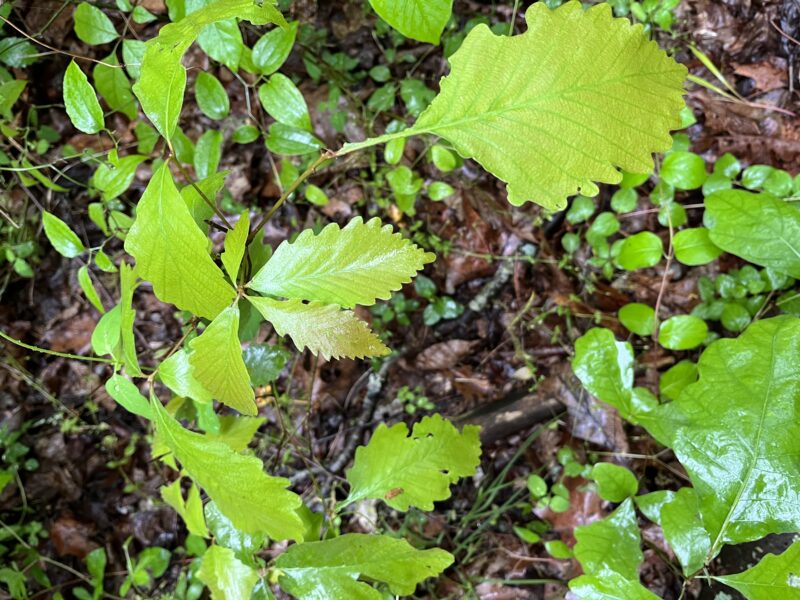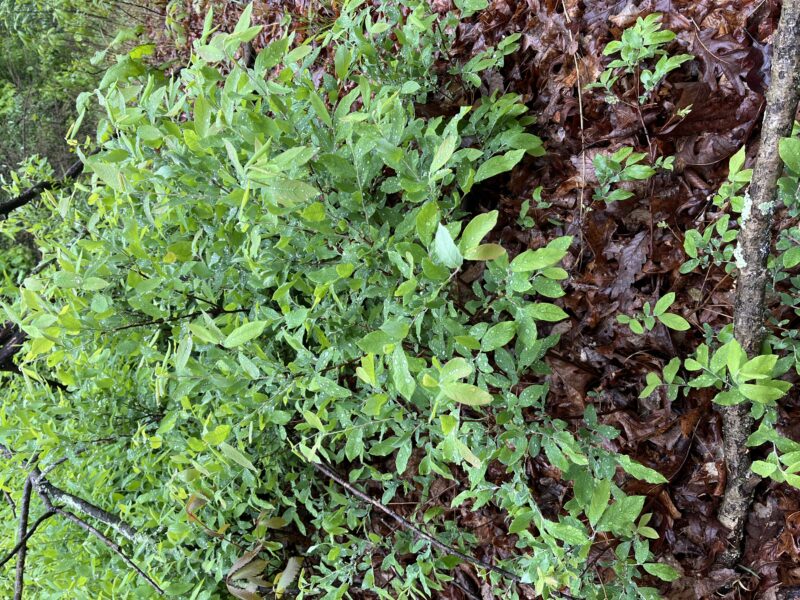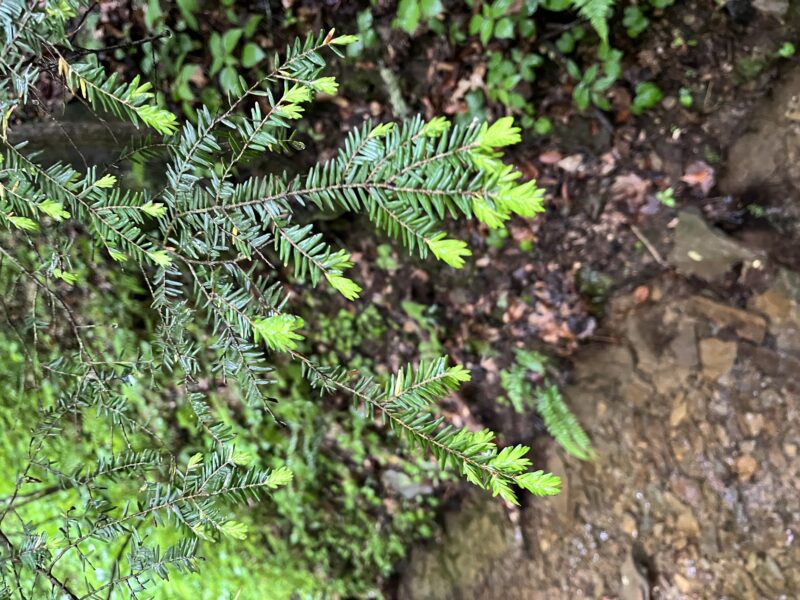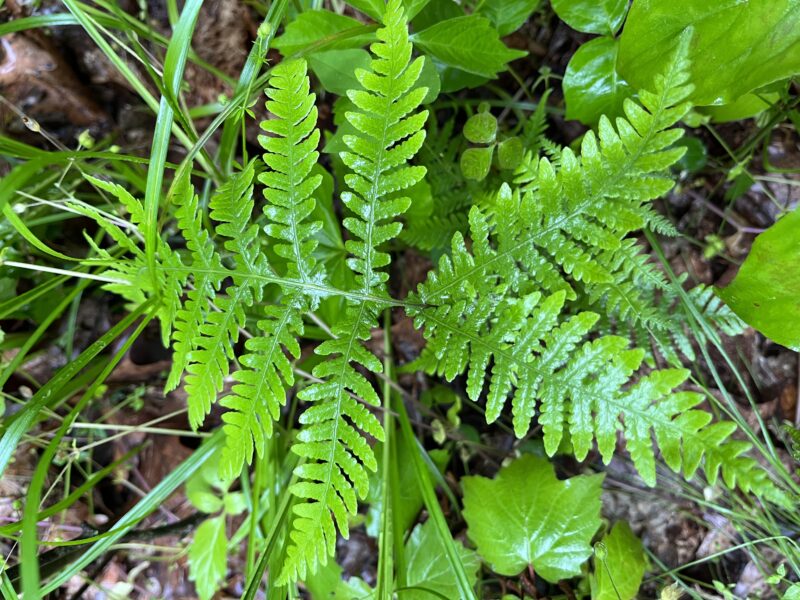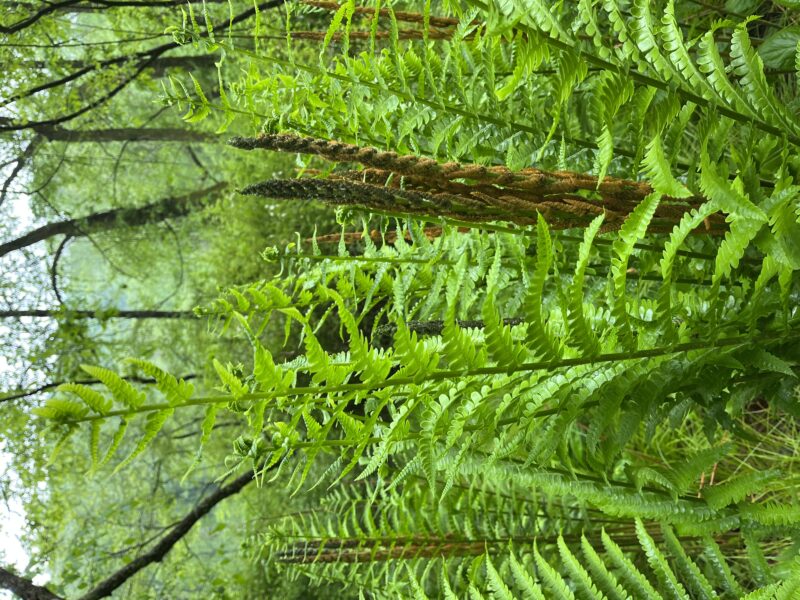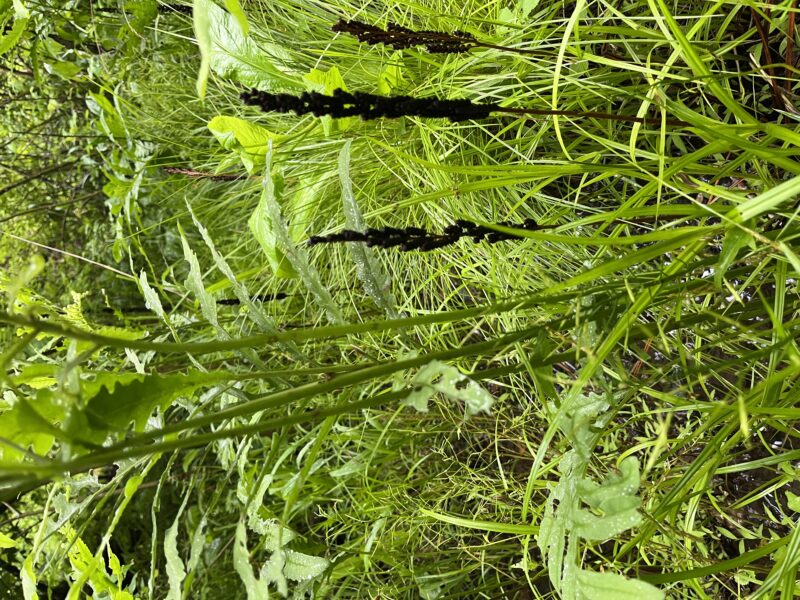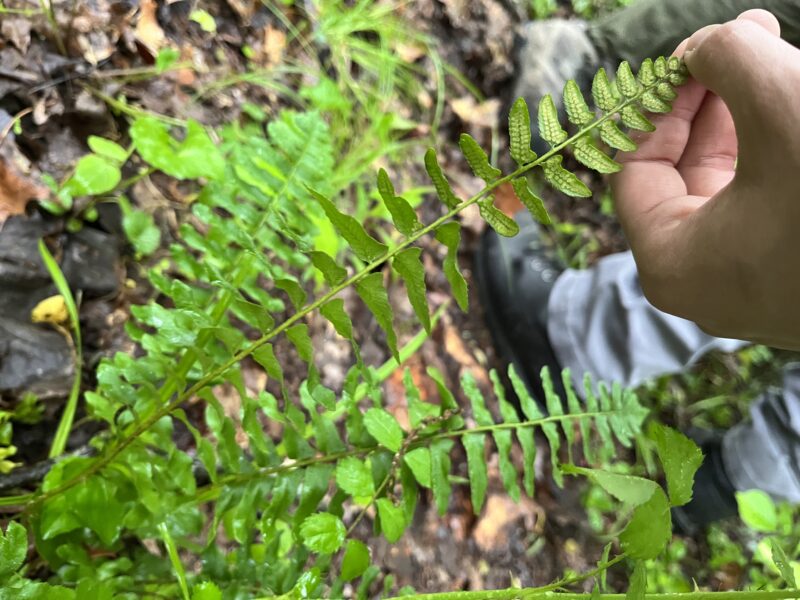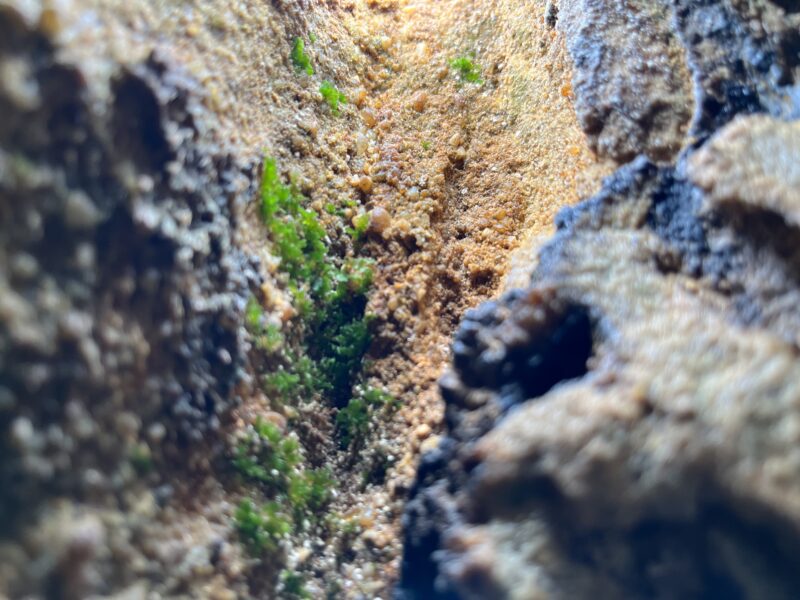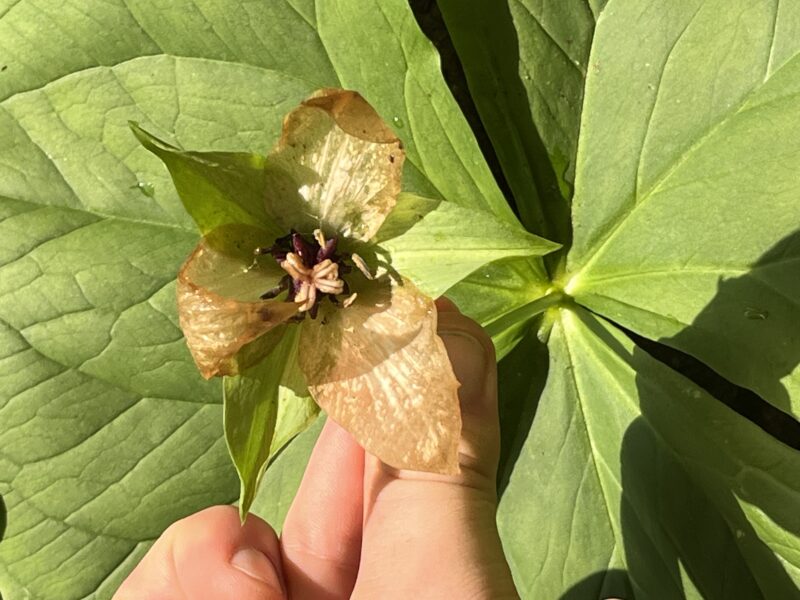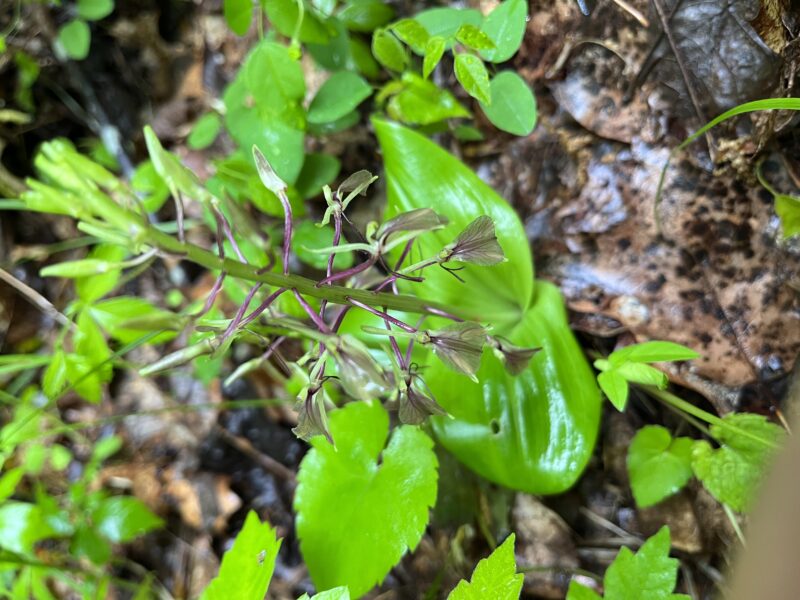Sandstone Acidophiles
Chestnut Oak
The Chestnut Oak (Quercus montana) is very closely related to White Oaks (Quercus albus), it shares a lot of properties with the group and is thus used for a lot of the same purposes. The lumber from Chestnut Oak is often used in furniture, floorboards, and other construction-related purposes due to its sturdy nature and its natural resistance to decay.
Deerberry (Blueberry Related!!)
Deerberry bush (Vaccinium stamineum) is another acidophile found in this region. It is extremely valuable to the surrounding ecosystem because of both its berries and flowers. Insects, birds, and small mammals feed off it along with many pollinators using it as their main host plant. Notably red-spotted purple (Limenitis arthemis astyanax) uses it as its main host plant.
Eastern Hemlock
Eastern Hemlock (Tsuga canadensis) has a lot of myths surrounding it, including the “fact” that it is poisonous. Eastern Hemlock is edible! (although I don’t think I would choose it over a deerberry…) For real uses (not including eating it), the since plant is very rich in vitamin C it can be used in many teas to battle scurvy
Sourwood
Sourwood (Oxydendrum arboreum) is the last acidophile we saw in this region. Sourwood has been used for medicinal uses in the past (just like most native plants in the United States have been :P) but in more recent years it has been extremely valuable in quality honey production. Sourwood produces honey that is so good that it has won the award for the best honey not once, but twice at the prestigious Apimondia World Honey Show.
Ferns!
Broad Beech Fern
The Broad Beech Fern (Phegopteris hexagonoptera), has a hemidimorphic frond type, with a pinnatifid frond dissection type, and a naked sorus (meaning no indusium). This fern is a close like-a-like to the Long Beech Fern, however, the fronds on this fern are simply lobed and not disconnected at any location, meaning it must be a Broad Beech Fern and not a Long Beech Fern.
Cinnamon Fern
The Cinnamon Fern (Osmunda cinnamomea), which does not taste like cinnamon… a regrettable mistake I made, is an interesting plant to look at due to its holodimorphic nature. One frond type is specifically for spores and the other is more vegetative and probably related more closely to large photosynthesis production in most cases. Besides its frond type, the Cinnamon Fern also has a pinnate-pinnatifid frond dissection type and a peltate indusium type.
Sensitive Fern
The Sensitive Fern (Onoclea sensibilis), is similar to the Cinnamon Fern but also very distinct in its own ways. The leaves of the sensitive fern are similar to the Cinnamon Fern in that they both are pinnate-pinnatifid frond dissection types, however, the lobes on the Sensitive Fern are less deep than the lobes seen on the Cinnamon Fern. Similarly again, the frond type is holodimorphic, although the fertile frond looks less like a thicker sterile frond and more like a bunch of berries. Lastly, the indusium is peltate due to its cluster-like nature.
Christmas Fern
The Christmas Fern (Polystichum acrostichoides), was very abundant at the Deep Woods site! It has a hemidimorphic frond type with a fertile section of the frond towards the tapering tip. Each frond is composed of many individual leaflets making it a pinnate frond dissection type. Lastly, the sporangia were more kidney bean-shaped, making them reniform indusium type.
Appalachian Gametophyte
The Appalachian Gametophyte (Vittaria appalachiana) was a great opportunity to truly visualize how small the gametophytes of these plants really are! In class we discuss it being as small as the end of a fingernail, but it doesn’t really make sense until you actually see it in person.
This species is so remarkable in relation to other ferns due to its primary life cycle stage being a gametophyte, hence the name. The majority of ferns (with this one being a very notable exception) start as a gametophyte, after becoming a zygote post-fertilization, until it produces the sporophyte which is the much larger part of most ferns. After the sporophyte forms, the gametophyte tends to wither away and will not be seen again until the next lifecycle. This species prefers to stay in the gametophyte stage over the sporophyte stage.
The gemmae are large in comparison to the spores which has adverse consequences on dispersal compared to most other ferns. It is more likely that the dispersal is over shorter distances since the size is much larger than normal. Wind, water, and likely animals are used to disperse the gemmae. The shorter distance dispersal theory is supported by the fact that even though this species can survive in northern conditions, it is not natively found more north than where the ice age glacier was. This is due to the shorter dispersal making it difficult to migrate far north.
Part of the reason the Appalachian Gametophyte is a gametophyte is due to it losing the ability to successfully produce a sporophyte. There is reason to believe that it once was able to produce a sporophyte due to it being in its current location. If it wasn’t originally from here then it had to have had a sporophyte at some point to be able to reach this area. However, there was a loss of this ability shortly before the Ice Age glaciers, this can be seen by the lack of dispersal in this time period to other areas.
An abrupt dispersal change for the Appalachian Gametophyte in my opinion would not be effective for the species trying to thrive elsewhere. My main argument against a long-distance dispersal method is the fact that it would not change that this plant lives in a small gametophyte form that can easily be overtaken by other plants. If the sporophyte being produced was actually a larger part of this plant and could photosynthesize and contribute to its fitness better then I might change my mind. However, as it currently stands, the gametophyte form is no bigger than someone’s fingernail and does not cluster in groups larger than the size of a hand’s palm. Other species invasive or not, could easily suffocate this species and would result in it not being able to live elsewhere. I think part of the reason this species is commonly seen in caves is due to it being devoid of much else, it gets to take advantage of its barren environment to grow in its small and conservative size. Outside of caves would be a larger struggle for this plant.
Invasive Plants
Multifloral Rose
The Multifloral Rose (Rosa multiflora), is originally from eastern Asian countries such as Japan, China, and Korea. It is a problem species in non-native habitats because it tends to form very thick walls of itself which can often kill surrounding plants due to smothering. Current efforts to remove the Multiflorial Rose struggle since it is a quite resilient plant. However, it has been found that consistent cutting or cutting and then applying an herbicide is very effective at killing localized areas of these plants. The problem is that it requires routine maintenance, but with time it can be managed appropriately.
Sources: https://mdc.mo.gov/trees-plants/invasive-plants/multiflora-rose-control
Japanese Stilt Grass
Japanese Stilt Grass (Microstegium vimineum), is another invasive species we encountered at the Deep Woods site. Contrary to what the common name suggests, the plant was originally imported from China and was first documented as being invasive in Tennessee. The main problem with the species comes from its growth pattern, Japanese Stilt Grass tends to grow in a knotted mat formation, which causes it to overlap on top of other plants suffocating them. This is evident when the plant is no longer in season and dies off, all of the plant life underneath is decimated and leaves a dead brown trail. It has been discovered that the roots do not burrow far down and can easily be pulled from the ground. This makes pulling in combination with trimming very effective for removing the plant as long as all of the plant is removed.
Source: https://extension.psu.edu/japanese-stiltgrass
My Assignment: 2 Monocots
Wake-Robin Birthroot
Wake-Robin Birthroot (Trillium erectum) is very similar to the Trillium that was seen at Darby Creek Park. Both the petals and sepals are larger than the species seen at Darby Creek Park. The stigma of the pistil is also much more pronounced and curls at its ends. Its notable features are the whorled leaves, flower parts of 3 making it a monocot, and the pronounced sepals behind the petals.
Orchid Large Twayblade
The orchid, Large Twayblade (Liparis lilifolia) has only basil leaves that are slightly heart-shaped. Notable features include its brown-purplish petals that are almost translucent. This orchid was much smaller than I was expecting it to be considering it is called the Large Twayblade. Regardless, I was very excited to have the opportunity to see a wild and native orchid.

